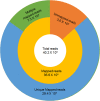Whole genome sequencing and analysis of Swarna, a widely cultivated indica rice variety with low glycemic index
- PMID: 26068787
- PMCID: PMC4464077
- DOI: 10.1038/srep11303
Whole genome sequencing and analysis of Swarna, a widely cultivated indica rice variety with low glycemic index
Abstract
Swarna is a popular cultivated indica rice variety with low glycemic index (GI) but its genetic basis is not known. The whole genome of Swarna was sequenced using Illumina's paired-end technology, and the reads were mapped to the Nipponbare reference genome. Overall, 65,984 non-synonymous SNPs were identified in 20,350 genes, and in silico analysis predicted that 4,847 of them in 2,214 genes may have deleterious effect on protein functions. Polymorphisms were found in all the starch biosynthesis genes, except the gene for branching enzyme IIa. It was found that T/G SNP at position 246, 'A' at position 2,386, and 'C' at position 3,378 in the granule bound starch synthase I gene, and C/T SNP at position 1,188 in the glucose-6-phosphate translocator gene may contribute to the low GI phenotype in Swarna. All these variants were also found in the genome of another low GI indica rice variety from Columbia, Fedearroz 50. The whole genome analysis of Swarna helped to understand the genetic basis of GI in rice, which is a complex trait involving multiple factors.
Figures




References
-
- Kaushik S. et al. Glycemic Index, Retinal Vascular Caliber, and Stroke Mortality. Stroke 40, 206–212 (2009). - PubMed
-
- Sheu W.H.H. et al. Addressing the burden of type 2 diabetes and cardiovascular disease through the management of postprandial hyperglycaemia: An Asian-Pacific perspective and expert recommendations. Diabetes Res. Clin. Pr. 92, 312–321 (2011). - PubMed
-
- Hu P., Zhao H., Duan Z., Linlin Z. & Wu D. Starch digestibility and the estimated glycemic score of different types of rice differing in amylose contents. J. Cereal Sci. 40, 231–237 (2004).
-
- Fitzgerald M.A. et al. Identification of a Major Genetic Determinant of Glycaemic Index in Rice. Rice 4, 66–74 (2011).
Publication types
MeSH terms
Substances
LinkOut - more resources
Full Text Sources
Other Literature Sources
Miscellaneous

